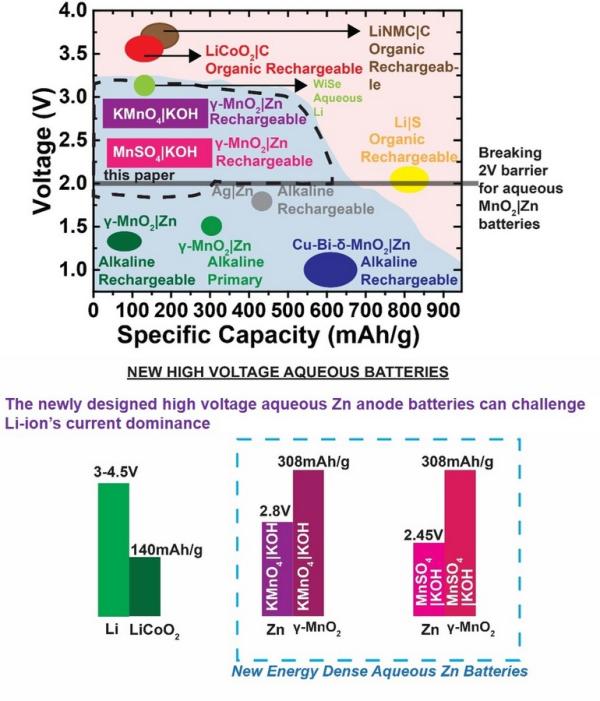
Photo credit: G.G. Yadav et al, ACS Energy Lett., 2019, 4, 2144-2146.
A new rechargeable high voltage manganese dioxide zinc battery, exceeding the 2 V barrier in aqueous zinc chemistry, is the latest invention by City College of New York researchers. With a voltage of 2.45-2.8V, the alkaline MnO2|Zn battery, developed by Dr. Gautam G. Yadav and his group in the CCNY-based CUNY Energy Institute, could break the long dominance of flammable and expensive lithium (Li)-ion batteries in the market.
To break the previously daunting 2 V barrier in aqueous zinc chemistry, primary inventor Yadav and his team interfacially engineered two different aqueous electrolytes that deliver the theoretical capacity (308mAh/g) reversibly for many cycles.
“The voltage of current commercially available alkaline MnO2|Zn batteries is around 1.2-1.3V, and this has been considered low compared to Li-ion which has a voltage >3V,” said Yadav.
Voltage has been Li-ion’s greatest asset and has helped fuel its rise in an energy hungry world.
“Unfortunately it contains elements that are toxic and geopolitically sensitive with Asian countries having a monopoly on mining and manufacturing them,” added Yadav.
“This has put the United States at a tremendous disadvantage and has lost its lead in energy storage industry, when in the past it was a world leader. With Mn and Zn being widely available elements, and with the U.S. being rich with them as well, it allows the U.S. to compete again. The manufacturing cost of these batteries will also be low, so it can kick start the growth of the energy storage industry in the U.S.”
Yadav’s collaborators from CCNY’s Grove School of Engineering included: Xia Wei, Jinchao Huang, Damon E. Turney and Sanjoy Banerjee, who is Distinguished Professor of Chemical Engineering and director of the CUNY Energy Institute.
Their research appears in the journal “ACS Energy Letters,” which publishes breakthrough energy-related research.
About the Grove School of Engineering
CCNY’s Grove School of Engineering celebrates a century of educating engineers this year. Originally established as the School of Technology in 1919, it evolved to the School of Engineering in 1962 and was renamed The Grove School of Engineering in 2005 in honor of alumnus Andrew S. Grove, whose $26 million gift to the institution that year is the largest in CCNY’s history. A distinguished member of CCNY’s Class of 1960, Grove was a founder and former chairman of Intel Corp, one of the world’s leading producers of semiconductor chips. Today, the Grove School remains the only public school of engineering in the heart of New York City.
About The City College of New York
Since 1847, The City College of New York has provided a high quality and affordable education to generations of New Yorkers in a wide variety of disciplines. CCNY embraces its role at the forefront of social change. It is ranked #1 by the Harvard-based Opportunity Insights out of 369 selective public colleges in the United States on the overall mobility index. This measure reflects both access and outcomes, representing the likelihood that a student at CCNY can move up two or more income quintiles In addition, the Center for World University Rankings places CCNY in the top 1.2% of universities worldwide in terms of academic excellence. More than 16,000 students pursue undergraduate and graduate degrees in eight professional schools and divisions, driven by significant funded research, creativity and scholarship. CCNY is as diverse, dynamic and visionary as New York City itself. View CCNY Media Kit.
Ashley Arocho
p: 212.650.6460
e:
aarocho@ccny.cuny.edu
View CCNY Media Kit